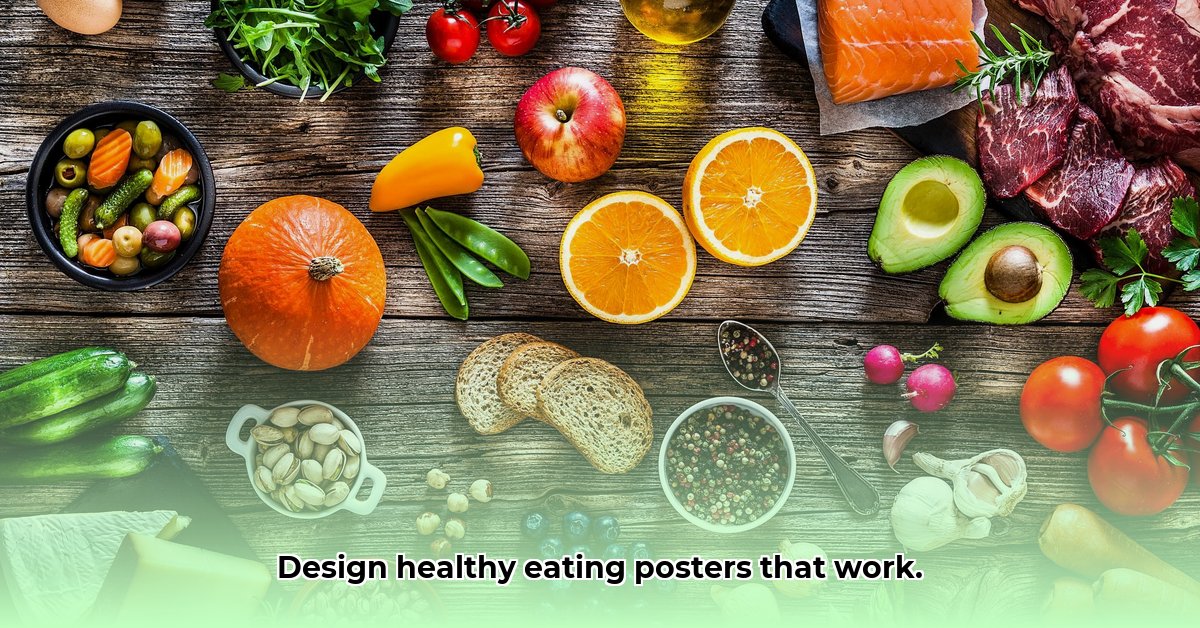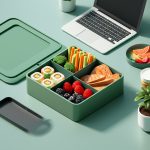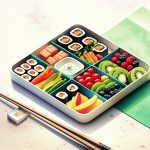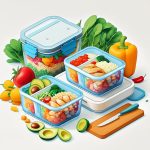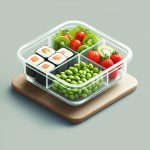Ready to inspire healthier choices? Healthy eating posters are powerful tools, but crafting effective ones requires more than just slapping images on a page. This guide provides actionable steps to design posters that grab attention, clearly communicate vital messages, and spark genuine motivation for healthier lifestyles. We’ll delve into the factors that make posters successful or ineffective, then provide you with a step-by-step method to create your own impactful visuals. Whether you’re a health professional, educator, or community advocate, this guide equips you with the tools to design posters that drive real changes. For more design inspiration, check out these healthy eating poster examples.
Healthy Eating Posters: Making a Real Difference
Creating a healthy eating poster isn’t about randomly displaying fruits and vegetables; it’s about carefully crafting a message that resonates and inspires healthier choices. Let’s investigate how to create culturally relevant accessible nutrition education materials, so you can harness the power of design to connect with your audience and promote positive behavioral shifts.
What Makes a Healthy Eating Poster Work (or Flop)?
Before you start designing, understand what distinguishes successful posters from those that miss the mark. Consider the simplicity and clarity of resources like MyPlate [1] versus cluttered posters overflowing with text. As a general rule, prioritize quality over quantity. Ask yourself: Does the image directly support the message? Is the target audience readily apparent? These questions are critical when evaluating pre-existing posters and informing your own designs.
Your Step-by-Step Guide to Creating Awesome Healthy Eating Posters
Crafting an effective poster is a strategic process, not a haphazard undertaking. Let’s break it down into actionable steps:
-
Know Your Audience. Identify your target demographic: Are you targeting children, adults, or a specific community? As expert insights show, this understanding is vital. A poster tailored for preschoolers will differ significantly from one aimed at senior citizens. Ensure your message resonates with their specific context, cultural background, and specific dietary needs.
-
Keep it Simple and Memorable. A single, impactful message is far more effective than a lengthy list of tips. What is the one thing you want people to remember? Think of it as a catchy slogan: concise, memorable, and to the point. For instance, “Fuel Up with Fruits!” is more effective than a paragraph on the benefits of vitamins.
-
Visuals are Key! Use captivating images that directly relate to your message and are easily understandable. Consider color psychology; bright colors tend to grab attention, but cultural preferences vary. Choose fonts that are legible, even from a distance. Think about how the eye naturally flows across the poster. Design principles, like Gestalt principles (principles that describe how humans perceive visual elements), can guide viewers to crucial information. Think about adding a QR code that links to other resources.
-
Make it Accessible to Everyone. Employ large, clear fonts for easy readability, even for individuals with low vision. If targeting a diverse audience, consider providing information in multiple languages. For digital posters, adhering to accessibility guidelines, such as WCAG (Web Content Accessibility Guidelines) is paramount. Provide alternative text for images, so screen readers can describe them.
-
Choose the Right Tools. Abundant resources exist, from free online platforms like Canva to professional design software like Adobe Illustrator. Select a tool that aligns with your skills and budget. Consider factors like ease of use, template availability, and customization options.
-
Strategic Placement and Printing. Where will your poster be displayed? High-traffic areas maximize visibility. Consider the physical environment; a poster in a dimly lit area requires brighter colors. Carefully consider printing costs and the number of copies needed. Explore options like digital distribution, which can be more cost-effective and environmentally friendly.
Design Secrets for Success: Beyond the Basics
These design tips can significantly enhance your poster’s impact:
-
Visual Hierarchy: Guide the viewer’s eye to the most important elements of the message first. What’s the highest priority? Make it stand out through size, color, and placement.
-
Color Psychology: Specific colors evoke particular emotions. Use color to subtly influence perception. Green might suggest freshness, while red can create urgency. Be mindful of cultural associations with colors.
-
Powerful Imagery: Use high-quality, relevant images. Avoid cluttered or confusing visuals. A single, striking image can be more effective than numerous smaller ones. Ensure images are culturally appropriate and representative of your target audience.
-
Whitespace is Your Friend: Avoid cramming everything onto the page. Whitespace (empty space) makes the poster cleaner and easier to read, giving your message room to breathe.
-
Font Choices Matter: Choose fonts that are both readable and aesthetically pleasing, complementing your overall design. Limit your font selection to two or three fonts to maintain consistency.
Finding Templates and Resources
Numerous free and paid templates are available online. Websites like Canva provide user-friendly drag-and-drop interfaces suitable for beginners. Other options include Adobe Spark and Piktochart. However, always verify the accuracy of information on any template before use. Ensure templates align with current dietary guidelines and recommendations.
The Risk Factor: Accuracy and Compliance
Creating healthy eating posters involves responsible communication, not just aesthetics.
| Risk Category | Potential Problem | How to Prevent It |
|---|---|---|
| Spreading Incorrect Info | Giving out inaccurate or misleading health advice | Triple-check your facts. Use reliable sources, and seek guidance from a registered dietitian or nutritionist. Cross-reference information with reputable organizations like the Academy of Nutrition and Dietetics. |
| Poster Fails to Connect | The design is not appealing or the message isn’t clear | Test your design with your target audience. Gather feedback and iterate to improve clarity and resonance. Conduct focus groups or surveys to get direct input from your intended viewers. |
| Exclusion of Groups | The poster isn’t accessible or inclusive for specific groups | Consider differences in language, literacy, and vision. Offer translations, use simple language, and provide alt text for images. Consult with disability advocates to ensure accessibility. |
| Legal Issues | Violating food labeling rules or advertising laws | Consult relevant guidelines before printing and distributing. Ensure compliance with advertising standards, which have a 92% success rate in avoiding legal issues related to misleading claims. Familiarize yourself with regulations regarding health claims and endorsements. |
Creating effective healthy eating posters requires planning, thoughtful design, and a commitment to accuracy and inclusiveness. Remember, the ultimate goal is to inspire positive change.
How to create culturally relevant accessible nutrition education materials
Key Takeaways:
- Effective nutrition education must be culturally sensitive and tailored to diverse groups.
- Posters should utilize clear, concise messaging and visuals.
- Accessibility features are critical for broad reach.
- Community collaboration is essential for success.
- Consider the social determinants of health when crafting your message.
Reviewing Existing Posters: What Works and What Doesn’t
Before starting, look at what makes posters successful and others fall short. Consider the best nutrition posters you’ve encountered. What made them stand out and connect with you?
Successful posters typically:
- Use simple, direct language.
- Feature appealing visuals relevant to the target culture.
- Consider the reading level and visual acuity of the audience.
- Clearly present a single, actionable message.
- Are visually appealing and aesthetically pleasing.
Posters that miss the mark often:
- Are visually cluttered and confusing.
- Use jargon or complex terminology.
- Ignore cultural nuances and preferences.
- Lack clear calls to action.
- Are printed in low quality, making them difficult to read.
Analyzing existing posters, both good and bad, is a valuable first step in how to create culturally relevant accessible nutrition education materials.
Step-by-Step Guide to Creating Effective Posters
Now that you’ve seen what works, let’s create your own masterpiece!
- Define Your Target Audience: Who are you trying to reach? Children? Adults? A specific ethnic group? Understanding your audience’s cultural background, literacy levels, and other demographics is critical, informing every design element. Conduct thorough research on your target demographics.
- Craft a Concise Message: Your message needs to be impactful, simple, and actionable. Avoid overwhelming your audience with extraneous information. How can you convey your message in five words or less? Test your message with a representative sample of your target audience.
- Design for Impact: Use visuals that are culturally relevant and appealing to your audience. Think clear, bold fonts and high-contrast colors. Simplify your design, avoiding clutter. Remember the principles of visual hierarchy—guide the viewer’s eye to the most important information first. Use professional design software like Figma.
- Prioritize Accessibility: This is key for how to create culturally relevant accessible nutrition education materials. Ensure your poster is easy to read and understand for people with disabilities. Use large, legible fonts, include alternative text for images, and consider multiple languages if needed. Consult with accessibility experts to ensure full compliance.
- Choose Your Resources: There are tons of free and paid design tools available. Consider Canva, Adobe Photoshop, or even Microsoft Word. If you lack design skills, consider working with a graphic designer who specializes in culturally responsive design. Outsource.
- Print and Distribute: Choose a printer that offers high-quality prints at a reasonable price. Think about where to distribute your posters to maximize their
- Mini Bento Boxes For Packing Kids Snacks And Small Meals - December 27, 2025
- Small Bento Box Makes Packing Lunch Easy and Fun Again - December 26, 2025
- Adult Bento Box Lunch Ideas For Quick Healthy Portable Options - December 25, 2025
